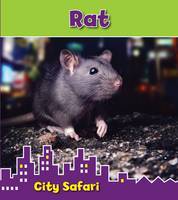Rat by Isabel Thomas 24 pages
While on the shelf with the Raccoon title above, I saw this title right next to it and thought why not? Actually when I first glanced at it I thought it said bat and I think bats are cute, but, when I realized it said Rat, well, can you ever learn enough about rats? I was game to see. I learned there are two varieties or wild rats – brown furred with small ears, thick fur and their tail the same length as their body and the black furred whose tail is longer than it’s body and it has large ears. O.K. I just learned a couple of things there. I never realized there were different varieties of street rats nor that they have different physical characteristics. Rats like to live wherever people do and they enjoy warm places for shelter, trash dumps, sewers, houses and backyards. They will eat anything people throw away. They too tend to stay hidden during the day and come out at night. They can sense both food and danger using their paws, whiskers and noses. They have great memories and won’t forget where they find food. Brown rats live in large groups (I shudder to think how many) and tend to be found in basements, garages and sewers. They dig burrows in backyards and underneath buildings which is how city inspectors know if a place is infested or not. Black rats are climbers they tend to live up high inside roofs and in the walls of buildings. (YIKES!) I like all animals, but, I have to say the thought of large numbers of these little fellows running around creeps me out a bit. I knew rats eat pretty much anything but I didn’t realize they eat baby birds, other mice, lizards and frogs. They are meat eaters afterall though they like fruit, vegetables and grain too. They hang out in droves at the local graineries. While as a rule rats are pretty savvy about dodging people outright, the occasional cat or dog hunt them and people try to trap them. Ms Thomas says most city rats die before they are one or two years old, but, I’m not so sure. Rats destroy or damage buildings with their gnawing but they also urinate and defecate every where they go and rats are known to carry diseases which can be spread in their droppings. Ms. Thomas says mother rats will share nests and help take care of each other’s babies together. Solidarity in the sisterhood of rats – you go, girls! Rats multiply quickly as they are ready to bear their own young at just 3 months old. WHEW! I have learned a lot more than I ever knew about rats. Well done, Isabel Thomas. Your books are really well done and the photography is terrific.
This blog is the home of the St. Louis Public Library team for the Missouri Book Challenge. The Missouri Book Challenge is a friendly competition between libraries around the state to see which library can read and blog about the most books each year. At the library level, the St. Louis Public Library book challenge blog is a monthly competition among SLPL staff members and branches. For the official Missouri Book Challenge description see: http://mobookchallenge.blogspot.com/p/about-challenge.h

No comments:
Post a Comment